Have you suffered a shoulder injury in the past that you haven’t fully recovered from? Perhaps you have a weak shoulder that’s holding you back from being active or doing your day to day activities properly? Do you exercise regularly and want to avoid shoulder problems in the future (eg. sports like tennis or golf where you use your arms a lot)? Or have you injured your shoulder before and want to prevent recurrence of shoulder injuries in the future?
The information in this article will be very useful for you!
A disclaimer: this article is not a substitute for proper physiotherapy or medical treatment and you should always be assessed by a fully qualified health practitioner if you have a shoulder injury or shoulder pain. The information you are about to read is not personalized advice, and should not replace the need to go and see a health professional.
Why is the shoulder so easily injured?
The shoulder joint provides a very wide range movement and more flexibility than almost any other joint in the body, for example your hip joint. Just think about it fro a second, you should be able to lift you arm right above your head, rotate your arm in circles, twist your arm, reach behind your back and so on. Your arm and shoulder are very flexible as an adaptation… an evolutionary adaptation that allows us to do things a lot easier in our day to day life.
However, because the shoulder requires so much more movement, it is also a relatively unstable joint. The cup in which the ball of the joint sits is shallow and there aren’t many structures holding it in place. That’s why shoulder dislocations are quite common. It doesn’t take much force to pull the ball of the joint out of the socket. An example of one of the most commonly injured structures in the shoulder joint is the rotator cuff muscles. You might have heard of rotate cuff injuries that are probably the most common type of shoulder problem.
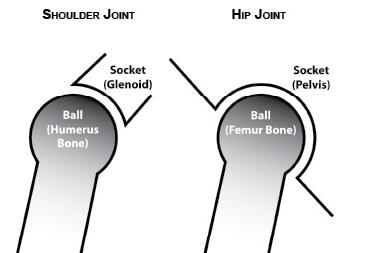
Source: https://www.researchgate.net/figure/Main-joints-of-human-body-a-Shoulder-joint-b-hip-joint_fig1_289548833
The shoulder is prone to injury also because of the complexity of the joint. Many muscles, tendons and ligaments attach around the area to create a complex mechanism. A good analogy would be a clockwork mechanism. If one of the bearings in a clockwork mechanism were to go out of place, the rest of the mechanism would fail. In many cases, the whole shoulder becomes dysfunctional. Therefore treating shoulder injuries requires an expert to assess different parts of the shoulder in order to make the right diagnosis.
The good news is that many common shoulder injuries are completely preventable.
Main types of shoulder injuries:
*** If you think you may have one of these injuries, please do not hesitate to contact a health professional for an accurate diagnosis and treatment.
Rotator cuff tear:
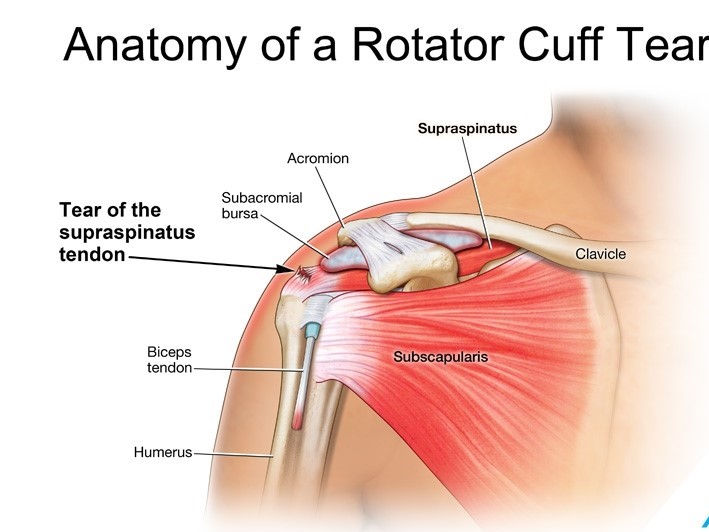
Source: https://mobilephysiotherapyclinic.in/rotator-cuff-injuries/
- One of the most common types of shoulder injuries
- Often caused by heavy or awkward lifting, or a bad fall (catching yourself)
- Common in contact sports
- Common in people over the age over 40
- May take a few months to get better depending on severity
- Some may require surgery in severe cases
Bursitis:
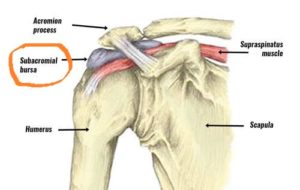
- Extremely common, often triggers when lifting the arm above the shoulder level
- Caused by a swollen bursa – a swollen sac of fluid sitting between the top of the shoulder (acromion) and rotator cuff tendons
- When lifting something heavy or falling on your arm, the ball of the shoulder joint pushes against the acromion and the bursa that sits in between gets squashed, causing it to become inflamed and swollen. The swollen bursa pushes against the tendon and causes pain and inflammation and discomfort
- Nothing is torn or broken, but can still be very painful
- Requires rehabilitation to restore normal shoulder balance, movement and strength
- Usually gets better with physiotherapy treatment, but may require a cortisone injection if treatment fails
Shoulder Joint Dislocation:
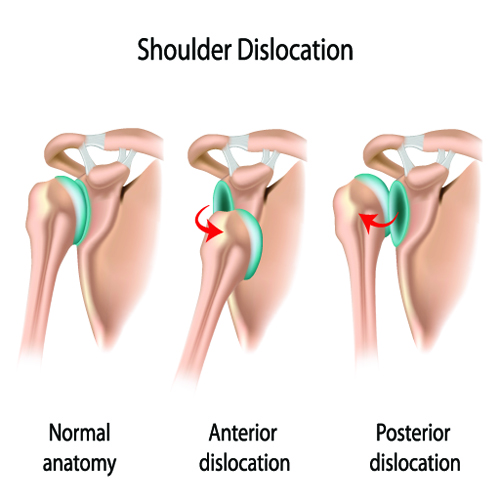
Source: https://coreem.net/core/shoulder-dislocation/
- Very painful
- Common in contact sports eg. rugby, karate
- Can also be caused by awkward arm positioning, eg putting on a wet suit (pushing your arm up and out and popping the arm out of the socket)
- The longer it is left untreated, the more painful it is to pop the shoulder back in
- Usually needs x-ray to check that bones haven’t been chipped or broken
- Usually needs post-injury rehab to make sure muscles are strong enough to keep the bowl in the socket
- If it happens 3 or more times in your lifetime, need surgery to prevent it from happening over and over
Frozen Shoulder:
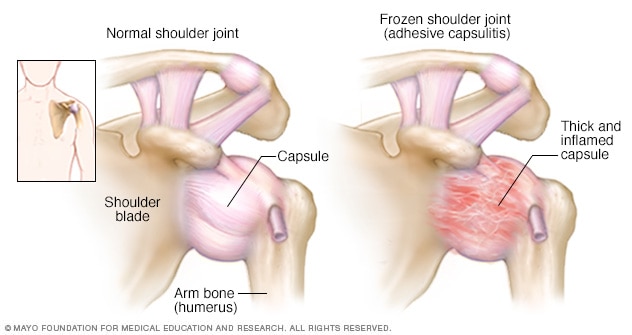
Source: https://www.mayoclinic.org/diseases-conditions/frozen-shoulder/symptoms-causes/syc-20372684
- Almost exclusively affects people from ages 40-60, more frequent in women than men
- More common in people with diabetes
- May be triggered by minor injury (eg. lifting a bag) or may have no apparent cause
- Symptoms include persistent and constant aching
- Great difficulty moving the affected arm
- Can take a long time to get better, up to 2 years, but does eventually get better
- Cortisone injection in the joint may help speed things up
3 Dangerous Mistakes To Avoid When You Have a Shoulder Injury:
-
Not getting a diagnosis from a health professional
A study done in 2011 shows that after 2-3 49% of full-thickness rotator cuff tears actually increase in size when left untreated (half of the people affected). Study Reference: Safran O, Schroeder J, Bloom R, Weil Y, Milgrom C. Natural history of nonoperatively treated symptomatic rotator cuff tears in patients 60 years old or younger. American Journal of Sports Medicine. 2011 Apr; 39(4):710-4
Another study showed that 40% of partial-thickness tears left untreated had progressed to a full-thickness tear over a 2 year period Source: https://www.ncbi.nlm.nih.gov/pubmed/21084574
If the injury is from a traumatic event (eg. bad fall, car accident) or if you are over 60 years of age), there is a risk of a fracture in the shoulder joint which would need surgical intervention.
-
Keeping the arm still or in a sling when it may need to be mobilized
Some injuries such as fractures and serious AC joint injuries require resting your arm in a sling, but many other times moving your arm is going to help you recover faster and regain lost mobility. Keeping shoulder or arm immobilized in a sling for long periods of time can be detrimental and may slow down your recovery times.
Examples of conditions that often do better when continuing to move the arm:
- Mild rotator cuff injuries
- Frozen shoulder
- Post-surgery and recovering
-
Not addressing the muscle imbalances and deficiencies around the shoulder girdle
A number of muscles control the position of the shoulder blade (see diagram), during an injury some of these muscles become weaker. As part of rehab, need to address those weaknesses. It will slow down recovery if shoulder blade, which is essentially the foundation of the shoulder, does not receive proper treatment. Important to check shoulder alignment.

For example, shoulder winging (see above) is a common injury where the muscle controlling the position of the shoulder and keeping the shoulder blade close to the chest wall is weak. If one shoulder is affect, this results in muscle imbalances.
Last but not least…
If you are based in Auckland, New Zealand and would like FREE advice from an expert physio, call Bodyfit Physiotherapy Group today and make a booking with us.
We have two clinics:
- Howick Recreation Centre
- Pakuranga Leisure Centre
We offer free 20-mins shoulder assessments so you can discover what your treatment options are and get x-rays/ultrasound scans done if necessary.
Call 0800 002723 to book or visit https://www.Growing YoungerPhysio.co.nz/FreeShoulderExam
